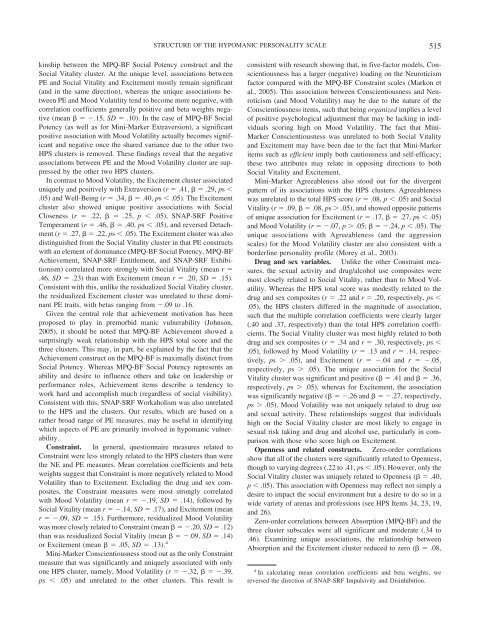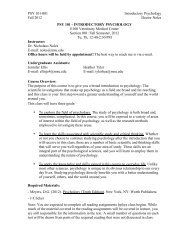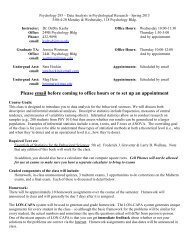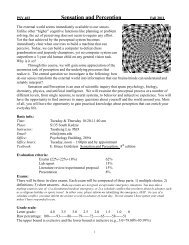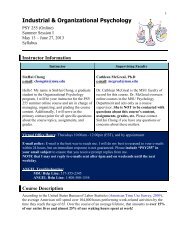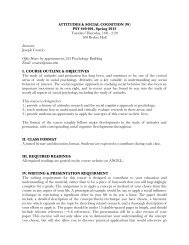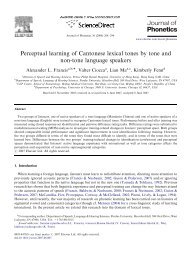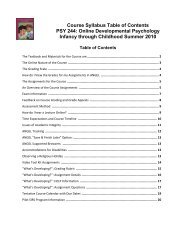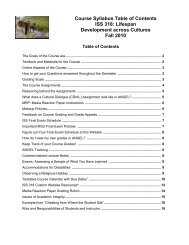Multidimensional Structure of the Hypomanic Personality Scale
Multidimensional Structure of the Hypomanic Personality Scale
Multidimensional Structure of the Hypomanic Personality Scale
Create successful ePaper yourself
Turn your PDF publications into a flip-book with our unique Google optimized e-Paper software.
STRUCTURE OF THE HYPOMANIC PERSONALITY SCALE515kinship between <strong>the</strong> MPQ-BF Social Potency construct and <strong>the</strong>Social Vitality cluster. At <strong>the</strong> unique level, associations betweenPE and Social Vitality and Excitement mostly remain significant(and in <strong>the</strong> same direction), whereas <strong>the</strong> unique associations betweenPE and Mood Volatility tend to become more negative, withcorrelation coefficients generally positive and beta weights negative(mean .15, SD .10). In <strong>the</strong> case <strong>of</strong> MPQ-BF SocialPotency (as well as for Mini-Marker Extraversion), a significantpositive association with Mood Volatility actually becomes significantand negative once <strong>the</strong> shared variance due to <strong>the</strong> o<strong>the</strong>r twoHPS clusters is removed. These findings reveal that <strong>the</strong> negativeassociations between PE and <strong>the</strong> Mood Volatility cluster are suppressedby <strong>the</strong> o<strong>the</strong>r two HPS clusters.In contrast to Mood Volatility, <strong>the</strong> Excitement cluster associateduniquely and positively with Extraversion (r .41, .29, ps .05) and Well-Being (r .34, .40, ps .05). The Excitementcluster also showed unique positive associations with SocialCloseness (r .22, .25, p .05), SNAP-SRF PositiveTemperament (r .46, .40, ps .05), and reversed Detachment(r .27, .22, ps .05). The Excitement cluster was alsodistinguished from <strong>the</strong> Social Vitality cluster in that PE constructswith an element <strong>of</strong> dominance (MPQ-BF Social Potency, MPQ-BFAchievement, SNAP-SRF Entitlement, and SNAP-SRF Exhibitionism)correlated more strongly with Social Vitality (mean r .46, SD .23) than with Excitement (mean r .20, SD .15).Consistent with this, unlike <strong>the</strong> residualized Social Vitality cluster,<strong>the</strong> residualized Excitement cluster was unrelated to <strong>the</strong>se dominantPE traits, with betas ranging from .09 to .16.Given <strong>the</strong> central role that achievement motivation has beenproposed to play in premorbid manic vulnerability (Johnson,2005), it should be noted that MPQ-BF Achievement showed asurprisingly weak relationship with <strong>the</strong> HPS total score and <strong>the</strong>three clusters. This may, in part, be explained by <strong>the</strong> fact that <strong>the</strong>Achievement construct on <strong>the</strong> MPQ-BF is maximally distinct fromSocial Potency. Whereas MPQ-BF Social Potency represents anability and desire to influence o<strong>the</strong>rs and take on leadership orperformance roles, Achievement items describe a tendency towork hard and accomplish much (regardless <strong>of</strong> social visibility).Consistent with this, SNAP-SRF Workaholism was also unrelatedto <strong>the</strong> HPS and <strong>the</strong> clusters. Our results, which are based on ara<strong>the</strong>r broad range <strong>of</strong> PE measures, may be useful in identifyingwhich aspects <strong>of</strong> PE are primarily involved in hypomanic vulnerability.Constraint. In general, questionnaire measures related toConstraint were less strongly related to <strong>the</strong> HPS clusters than were<strong>the</strong> NE and PE measures. Mean correlation coefficients and betaweights suggest that Constraint is more negatively related to MoodVolatility than to Excitement. Excluding <strong>the</strong> drug and sex composites,<strong>the</strong> Constraint measures were most strongly correlatedwith Mood Volatility (mean r .19, SD .14), followed bySocial Vitality (mean r .14, SD .17), and Excitement (meanr .09, SD .15). Fur<strong>the</strong>rmore, residualized Mood Volatilitywas more closely related to Constraint (mean .20, SD .12)than was residualized Social Vitality (mean .09, SD .14)or Excitement (mean .05, SD .13). 4Mini-Marker Conscientiousness stood out as <strong>the</strong> only Constraintmeasure that was significantly and uniquely associated with onlyone HPS cluster, namely, Mood Volatility (r .32, .39,ps .05) and unrelated to <strong>the</strong> o<strong>the</strong>r clusters. This result isconsistent with research showing that, in five-factor models, Conscientiousnesshas a larger (negative) loading on <strong>the</strong> Neuroticismfactor compared with <strong>the</strong> MPQ-BF Constraint scales (Markon etal., 2005). This association between Conscientiousness and Neuroticism(and Mood Volatility) may be due to <strong>the</strong> nature <strong>of</strong> <strong>the</strong>Conscientiousness items, such that being organized implies a level<strong>of</strong> positive psychological adjustment that may be lacking in individualsscoring high on Mood Volatility. The fact that Mini-Marker Conscientiousness was unrelated to both Social Vitalityand Excitement may have been due to <strong>the</strong> fact that Mini-Markeritems such as efficient imply both cautiousness and self-efficacy;<strong>the</strong>se two attributes may relate in opposing directions to bothSocial Vitality and Excitement.Mini-Marker Agreeableness also stood out for <strong>the</strong> divergentpattern <strong>of</strong> its associations with <strong>the</strong> HPS clusters. Agreeablenesswas unrelated to <strong>the</strong> total HPS score (r .08, p .05) and SocialVitality (r .09, .08, ps .05), and showed opposite patterns<strong>of</strong> unique association for Excitement (r .17, .27, ps .05)and Mood Volatility (r .07, p .05; .24, p .05). Theunique associations with Agreeableness (and <strong>the</strong> aggressionscales) for <strong>the</strong> Mood Volatility cluster are also consistent with aborderline personality pr<strong>of</strong>ile (Morey et al., 2003).Drug and sex variables. Unlike <strong>the</strong> o<strong>the</strong>r Constraint measures,<strong>the</strong> sexual activity and drug/alcohol use composites weremost closely related to Social Vitality, ra<strong>the</strong>r than to Mood Volatility.Whereas <strong>the</strong> HPS total score was modestly related to <strong>the</strong>drug and sex composites (r .22 and r .20, respectively, ps .05), <strong>the</strong> HPS clusters differed in <strong>the</strong> magnitude <strong>of</strong> association,such that <strong>the</strong> multiple correlation coefficients were clearly larger(.40 and .37, respectively) than <strong>the</strong> total HPS correlation coefficients.The Social Vitality cluster was most highly related to bothdrug and sex composites (r .34 and r .30, respectively, ps .05), followed by Mood Volatility (r .13 and r .14, respectively,ps .05), and Excitement (r .04 and r .05,respectively, ps .05). The unique association for <strong>the</strong> SocialVitality cluster was significant and positive ( .41 and .36,respectively, ps .05), whereas for Excitement, <strong>the</strong> associationwas significantly negative ( .26 and .27, respectively,ps .05). Mood Volatility was not uniquely related to drug useand sexual activity. These relationships suggest that individualshigh on <strong>the</strong> Social Vitality cluster are most likely to engage insexual risk taking and drug and alcohol use, particularly in comparisonwith those who score high on Excitement.Openness and related constructs. Zero-order correlationsshow that all <strong>of</strong> <strong>the</strong> clusters were significantly related to Openness,though to varying degrees (.22 to .41, ps .05). However, only <strong>the</strong>Social Vitality cluster was uniquely related to Openness ( .40,p .05). This association with Openness may reflect not simply adesire to impact <strong>the</strong> social environment but a desire to do so in awide variety <strong>of</strong> arenas and pr<strong>of</strong>essions (see HPS Items 34, 23, 19,and 26).Zero-order correlations between Absorption (MPQ-BF) and <strong>the</strong>three cluster subscales were all significant and moderate (.34 to.46). Examining unique associations, <strong>the</strong> relationship betweenAbsorption and <strong>the</strong> Excitement cluster reduced to zero ( .08,4 In calculating mean correlation coefficients and beta weights, wereversed <strong>the</strong> direction <strong>of</strong> SNAP-SRF Impulsivity and Disinhibition.


